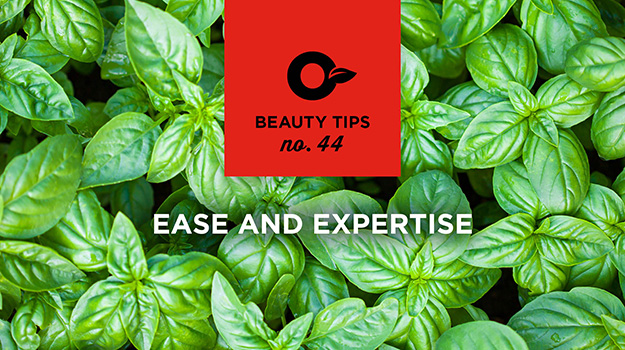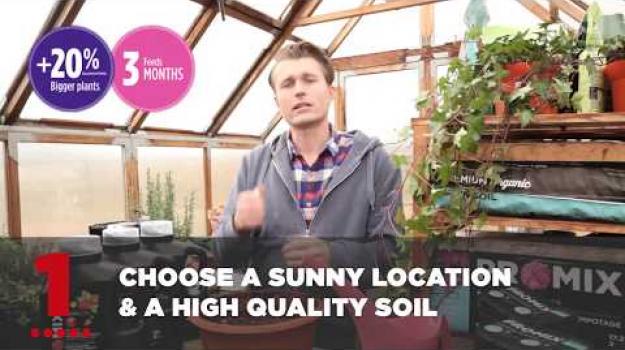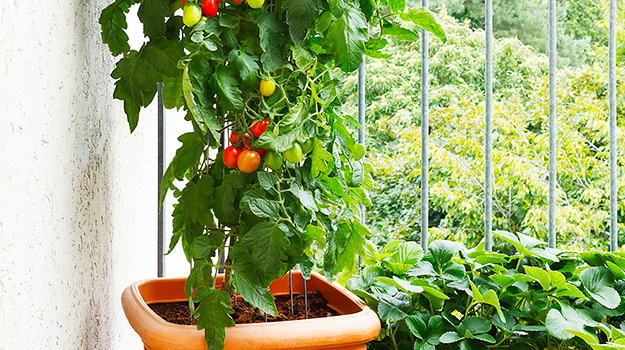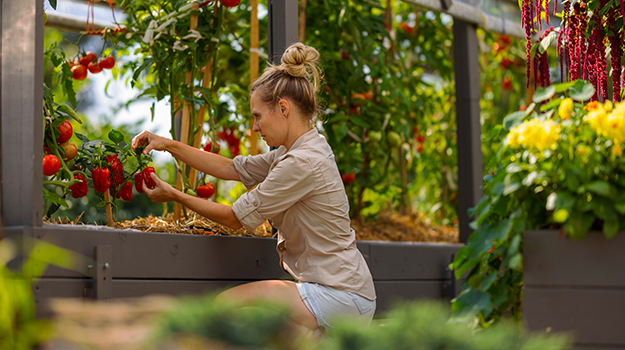
You’re a gardener at heart but think you don’t have enough space to grow anything? If you have access to a balcony, a terrace or a paved area, urban agriculture is for you!
The idea is both simple and appealing: it consists in growing various plants within the space you have, whether it is vertically or horizontally. Urban gardens are currently the hottest horticulture trend, and something tells us they’re here to stay!
Depending on what you choose to grow, a container garden can be resplendent from May to October. That opens a world of possibilities. Even those who have a big garden adopt this increasingly popular movement. Gone are the days when balcony planters were reserved for begonias and tubs for geraniums. After all, why settle for annuals and herbs when virtually any plant can be grown on the patio?
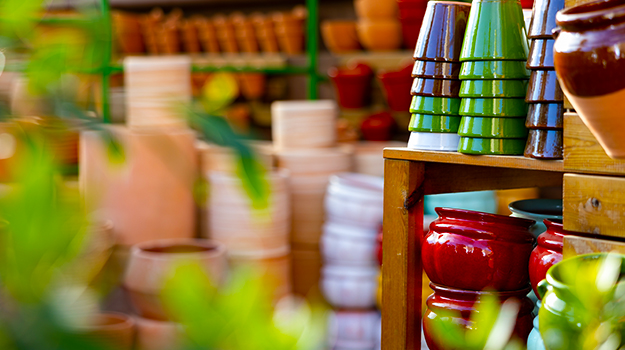
Which containers to choose?
Terracotta, reconstituted stone, cement, plastic... There's a wide variety of containers available on the market, both for planting and for other purposes. Beyond hanging planters, window boxes, pots, grow bags, urns, tables and tubs, anything that can hold soil can be used. Slight modifications can be made if necessary.
The chosen containers must meet the following 3 criteria:
- They have been cleaned (or disinfected);
- They have drainage holes (otherwise, drill at least 3 good-sized holes);
- Their depth is adapted to the length of the plant’s roots.
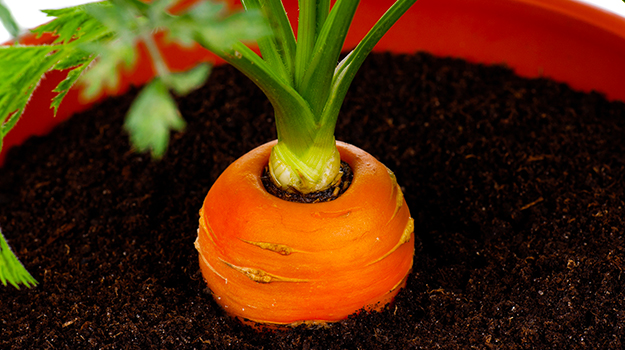
How to choose containers
Choosing a pot isn't just about aesthetics. The container must meet the plant's needs, particularly by allowing its root system to develop. Knowing that carrots twist and deform when they come across rocks during the growing season, it’s easy to understand that the depth of the container is important.
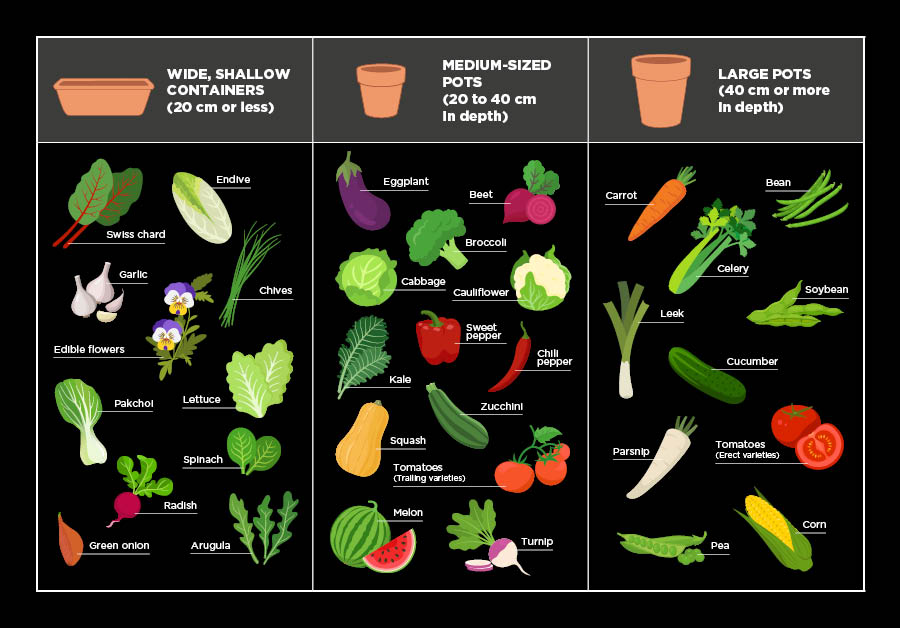
Your vegetables won't be growing directly in the ground, so they'll have to draw the water and nutrients they need from the space they're given. Make sure they're not too cramped!
How to plant a container garden
The advantage of growing in pots is that you don't have to worry about the quality of the soil in your garden. To ensure your vegetables grow in optimal conditions, simply fill your containers with a quality potting soil that's both rich and light.
A product containing sphagnum peat moss will promote water and nutrient retention. You won’t have to water as much and will also save time and money. It is a sensible choice for a better management of resources in a context of sustainable development.
TIP: Square foot gardening allows you to maximize your space and optimize production while facilitating access to the various plants. This method involves dividing the area of a large container into squares of approximately 30 cm each. Thus, in a 60 cm x 90 cm container, you will have 6 squares to grow. In each square, you will plant a variety of edible plant, spacing plants as recommended.
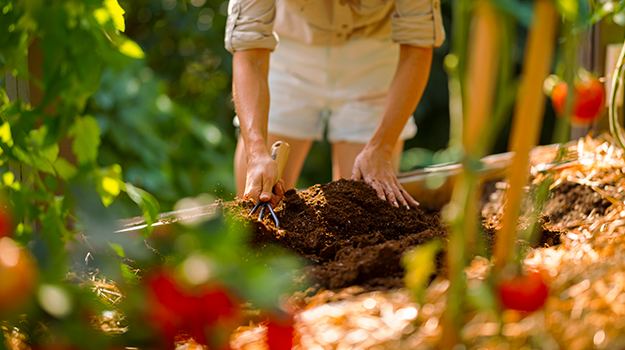
Which soil to choose for container growing?
Black soil, which contains no nutrients, is simply not an option. Instead of using a homemade mix you’re not too certain of, you can opt for a product specifically designed to promote plant growth.
Our suggestions: PRO-MIX Premium Potting Mix, which contains a growth stimulant, and PRO-MIX Organic Vegetable and Herb Mix. In addition to the sphagnum peat moss, they contain an organic slow-release fertilizer that feeds your plants for up to 3 months. They also benefit from the MYCOACTIVE technology for a stronger root system and better resistance to drought and disease.
When planting, make sure the crown (where the stem and roots meet) is level with the surface of the potting soil. Then add a little potting soil, but don't pack it down. Don't overfill to prevent water from overflowing when watering. The potting soil should be 2 to 3 cm from the rim.
Water thoroughly after planting, until water runs out of the drainage holes. If air bubbles have formed, watering will remove them. If necessary, add a little more potting soil to restore the desired level. Level the surface and water again.
You can already install stakes for plants that are likely to bend under the weight of vegetables, as well as trellises for climbers. You'll save space and promote a bountiful harvest!
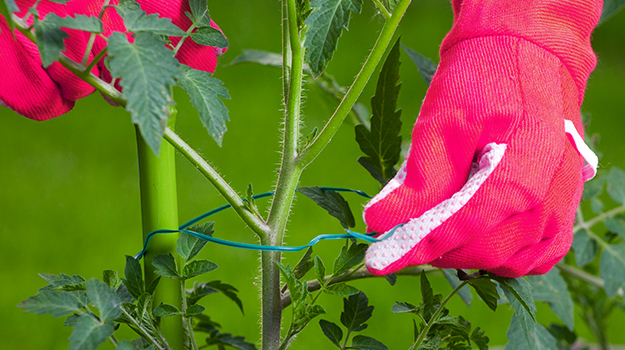
TIP: In a container that is much deeper than your plants need, you can save by filling the container as follows, from the bottom up. The first layer, at the very bottom, is made up of cardboard (5%), the second of wood logs (45%), the third of organic waste, leaves, vegetable peelings, etc. (10%), the fourth of compost (10%), and the fifth of organic potting soil (30%). Refer to the previous chart to ensure that the depth of the upper layers meets the needs of the vegetables that will be planted.
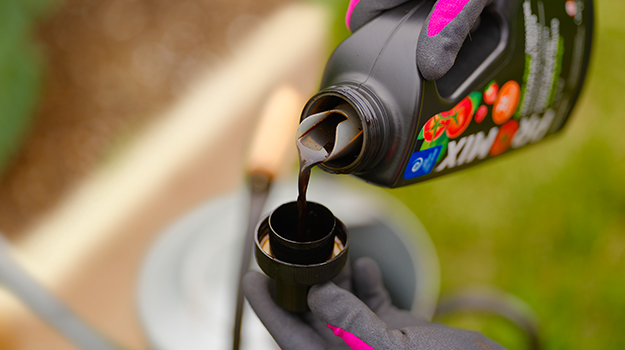
Fertilize potted vegetables
During the season, you can add a concentrated fertilizer designed to be diluted in water or a soluble fertilizer. Fertilizing when watering allows the roots to quickly absorb nutrients and promotes a bountiful production of fruits and veggies.
Opt for organic fertilizers, which do not contain pesticides or other contaminants.
OUR ADVICE: If your arrangement includes edible and ornamental plants, make sure to meet the needs of your edible plants first.
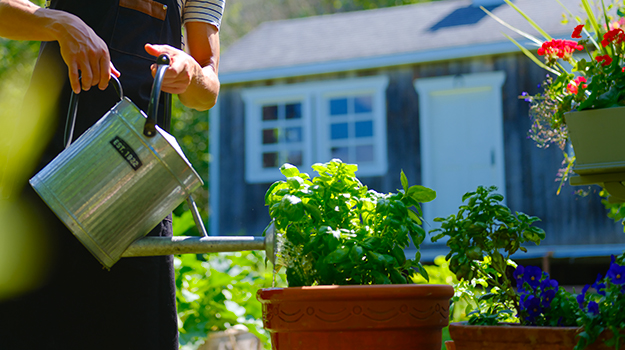
Watering and drainage: what you must know
Potted plants require more frequent waterings than those planted directly in the ground because they don't have access to the same water reserves. To prevent them from drying out, moderate but regular watering is ideal. They should generally be watered every other day in cool weather, and daily in very hot weather.
Don't water if it’s not necessary! Check the soil moisture beforehand. If you must water, do it preferably in the morning. Water deeply, until water flows through the drainage holes to encourage the roots to develop and draw water from deeper down. Plants with surface roots will be less resistant to drought. If your pots are placed in saucers, empty the residual water after about twenty minutes to prevent rot.
Unless you're planting in a huge, bottomless container placed directly on the ground, don't put logs, cardboard or pebbles at the bottom of the container. The holes at the bottom of the container are sufficient to ensure drainage and prevent your plant from drowning. A diameter of 1 to 2 cm is sufficient to effectively drain excess water. If necessary, you can enlarge them or add more.
TIPS: Going away for the weekend? Move your plants to a shaded spot and water them thoroughly before leaving. You can also buy drip irrigation systems at garden centres, or make your own from soda bottles. Simply pierce the cap before pushing the spout into the soil. However, if you're going away for an extended stay, it's a good idea to ask a neighbour to come water (and harvest!) your plants while you're away.
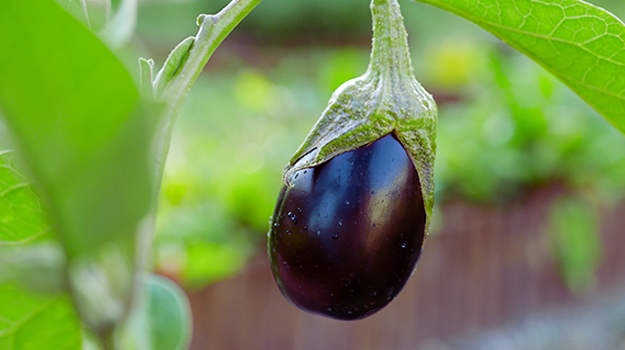
Sun or partial shade… which vegetable to plant where?
While most vegetable plants need at least six hours of sunlight per day to thrive and produce abundantly, others can do with less. This is the case, for example, with carrots, lettuce and most cabbages.
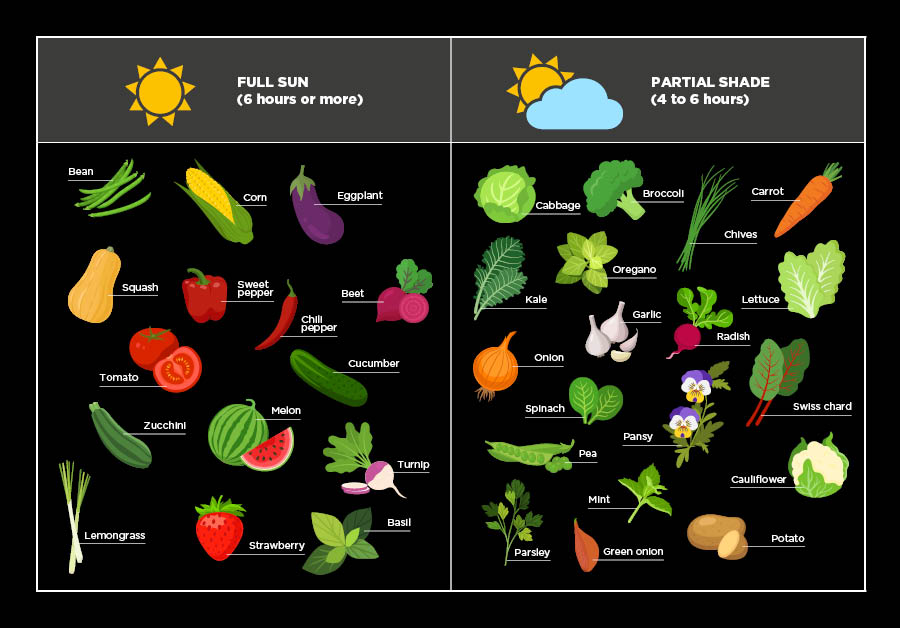
OUR TIPS: Protect your vegetable plants from prevailing winds, especially those that have grown beyond your expectations and whose pot would more easily be tipped over. Also consider protecting your vegetables from water coming from upper balconies or rooftops.
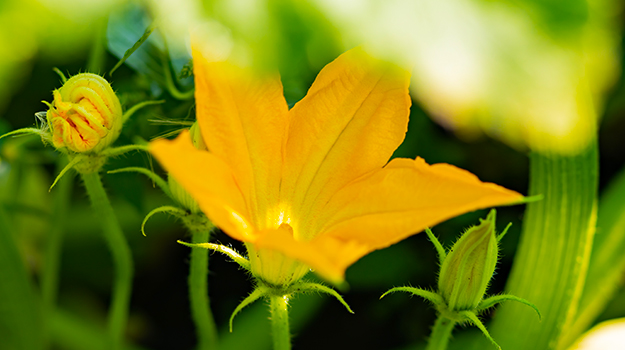
When competition is too intense
If you've ever planted mint in the ground, chances are it's still creeping through your plants, even if you've since confined it to a pot. Mint is difficult to control and can easily become invasive, so unless you have a huge garden where you can afford to let it run free, it's best to grow it in a pot.
For the same reason, in a container, it will quickly take up all the space, pushing its way in between its companions, suffocating them in the process. It is therefore better to grow it alone in its pot.
For different but equally valid reasons, the same goes for vegetables like zucchini and asparagus. With stems over two metres long and big yellow flowers contrasting with its deep green foliage, zucchini looks stunning on its own, on a large trellis that stretches toward the sky!
Growing asparagus in pots isn’t recommended either, as the first harvest will take three years. It is better to plant it directly in the ground and give it space to grow and proliferate.
OUR TIP: Want to make your own planter? Choose cedar instead of treated wood, which, while less toxic than before, still contains chemicals. The size should not exceed 120 cm by 120 cm to allow easy access to the plants in the centre.
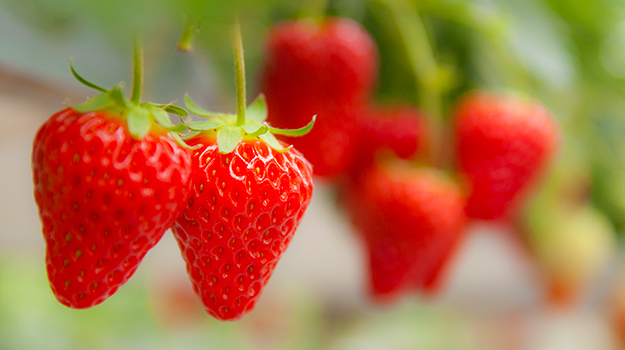
Up in the air
While cucumbers, zucchini, peas and beans are all fabulous climbers, some vegetable plants look amazing hanging in the air. This is the case with certain varieties of cherry tomatoes, strawberries and even ground cherries, which grow into appetizing cascades!
Other than hanging planters, wall pockets are also a good option, allowing you to add greenery to a wall in no time and increase your growing space tenfold. They can be used to grow herbs and lettuce.
These bags made from flexible recycled materials have been so popular since their introduction on the market that manufacturers have developed unique products for specific crops and needs.
Planting bags are easy to clean and fold up when fall comes. They take up little space and can be quickly stored away until the following spring.
TIP: There are potato grow bags with Velcro at the bottom that make it easy to harvest potatoes without having to disturb the plant too much.
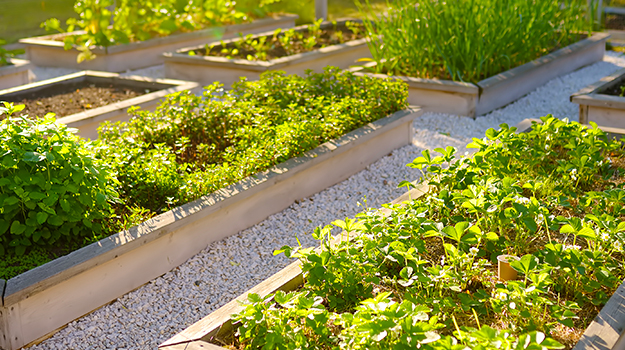
What is companion planting?
While some plants prefer to be alone in their pot, most enjoy good company. You can create potted arrangements that are both beautiful and tasty. Just make sure the plants you choose have similar needs.
It is also important to know that some vegetable plants benefit from being planted together while others do not. That is the principle of companion planting.
This growing technique involves planting together two or more plant species that benefit each other. The advantages are numerous: repelling insects, conditioning the soil, promoting pollination, creating shade, maximizing space, providing shelter for beneficial insects, stimulating plant growth and increasing production.
Conversely, plants that do not coexist well will tend to compete for soil nutrients, available space, etc. The strongest ones will prevail, but their production will be affected.
Read our article to learn more about companion planting: The Benefits Of Companion Gardening
OUR ADVICE: Considering planting coriander with your carrots? They make good companions for each other. However, grown in a pot, coriander tends to flower and set seed too quickly. Like a few other herbs, it's best to plant it directly in the ground.
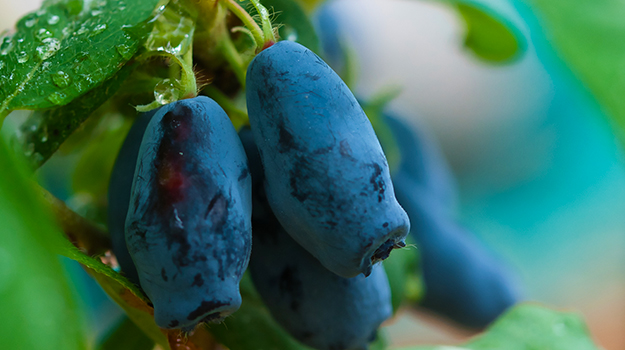
Varieties that will cause a sensation
Here are some great suggestions for your container garden. Some of the vegetable plants featured here are surprisingly productive, others beautifully decorative or quite unique. Some are all of these things!
Honeysuckle - This little-known shrub blooms early in spring and produces tangy blue berries in June. As it is not self-fertile, two plants must be planted side by side, one male and one female. It must be protected in winter.
Raspberry Shortcake - This self-fertile, compact and thornless raspberry plant is perfect for the patio. In June and August, it will produce sweet fruit with a slight taste of vanilla. It should be planted in a pot at least 40 cm deep and protected in winter.
Cantaloupe Sugar Cube – A variety that reaches maturity in our climate!
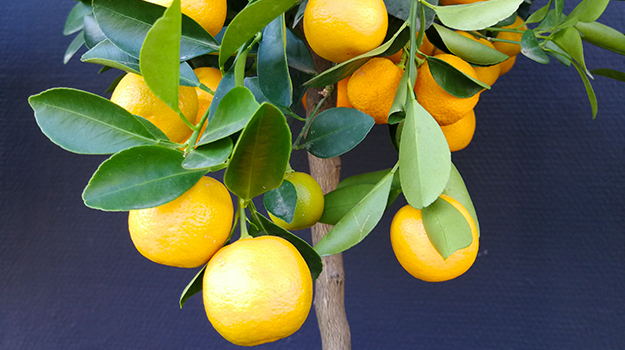
Ground cherry Pinata – To brighten up both your patio and dishes!
Lemon tree - Lemons can be grown in northern regions! Simply bring your tree inside before the first frost and keep growing it in winter.
Strawberry Toscana - Pink flowers and an abundance of fruit. Interesting to know: all pink-flowered strawberries are said to be everbearing, so they don't just produce a single harvest in June!
Eggplant Patio Baby - Cute as can be, it produces tiny eggplants with a delicious taste.
Cucumber Fresh Pickles - Compact and very productive, it is ideal for growing in pots and for snacking.
Indeterminate tomatoes – Although all tomatoes and cherry tomatoes can be grown in pots, indeterminate varieties are interesting because of their columnar shape and spectacular height.
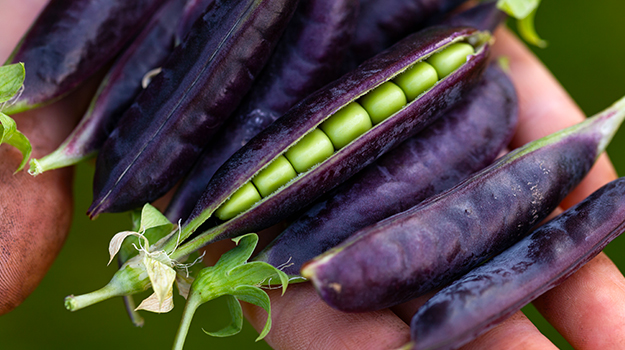
Snow peas Little Marvel and Blue Pod Capucijner – Productive and little demanding, snow peas Little Marvel produce sweet and crunchy pods that can be eaten whole or shelled, while snow peas Blue Pod Capucijner, with their purple pods, are both decorative and delicious.
Beet Bull's Blood - Its purple foliage can also be eaten in salads and brightens up any dish!
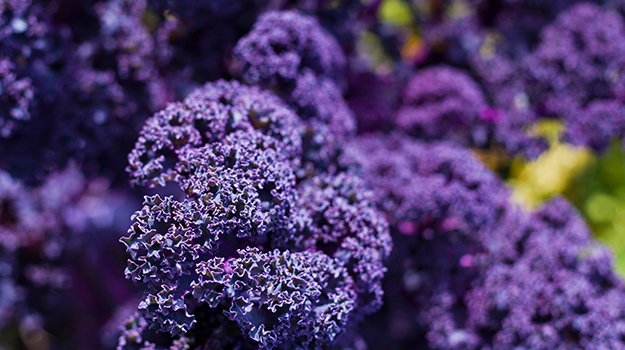
Kale Redbor – Easy to grow and tolerating temperatures as cold as -10 °C, its harvest period is one of the longest.
GOOD TO KNOW: Several garden centres offer a selection of vegetable plants that are perfectly suited to container gardening. Discover the Patio series, whose plants are more compact and produce profusely in pots!

